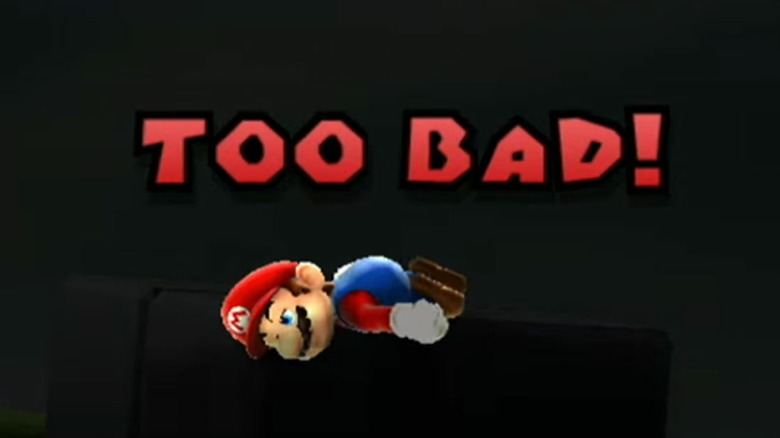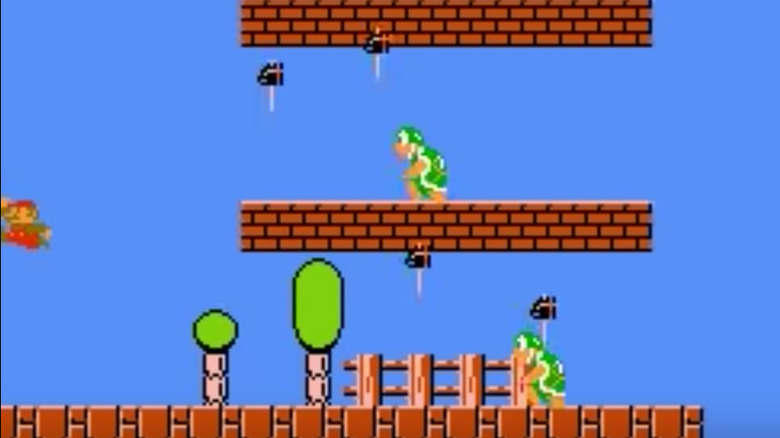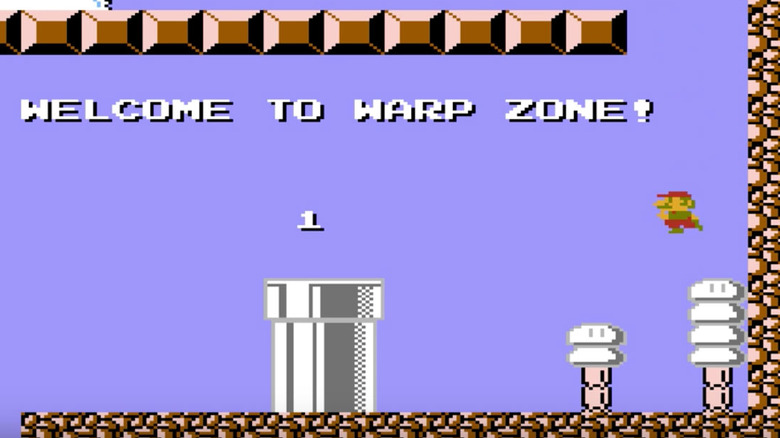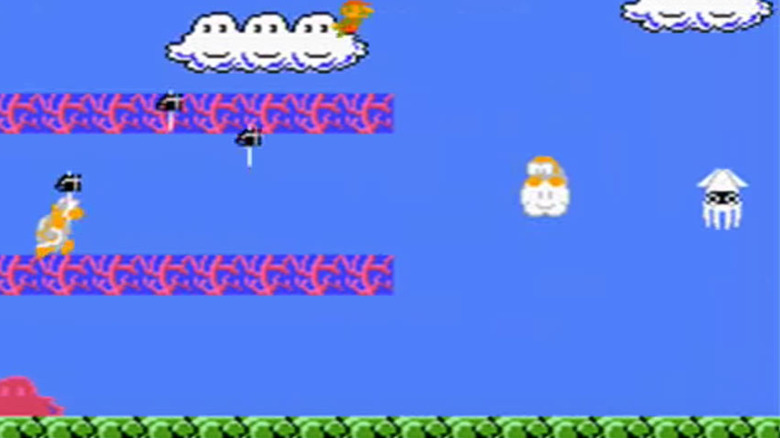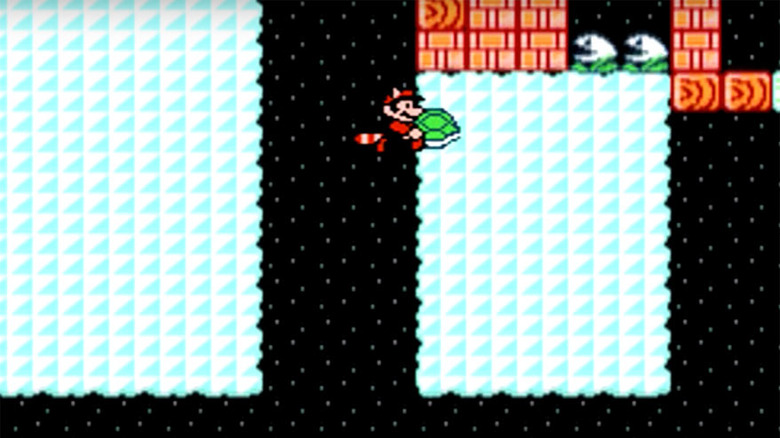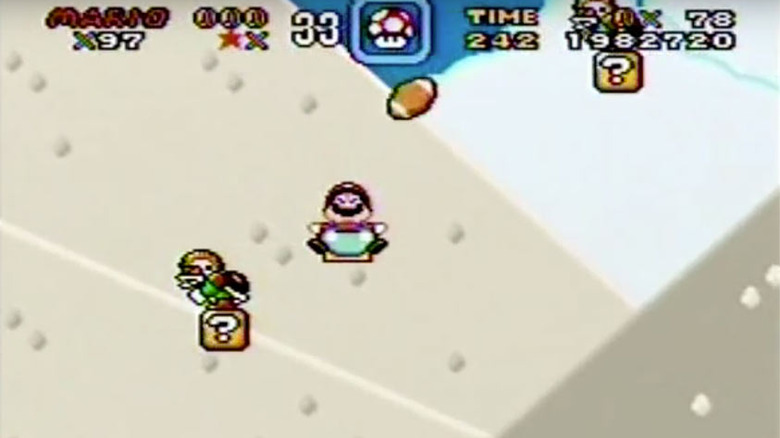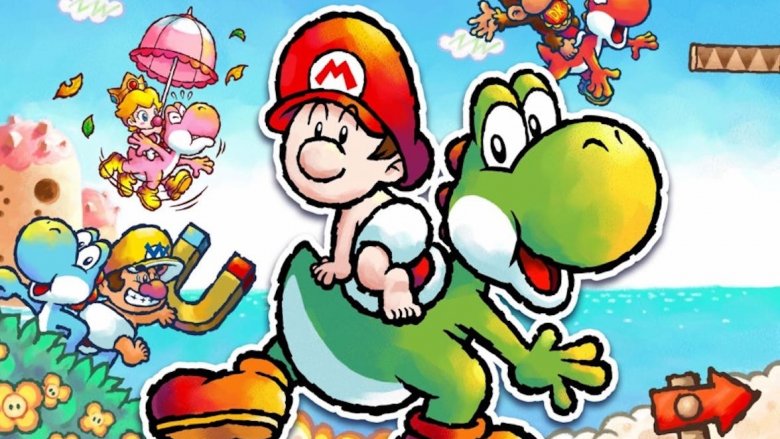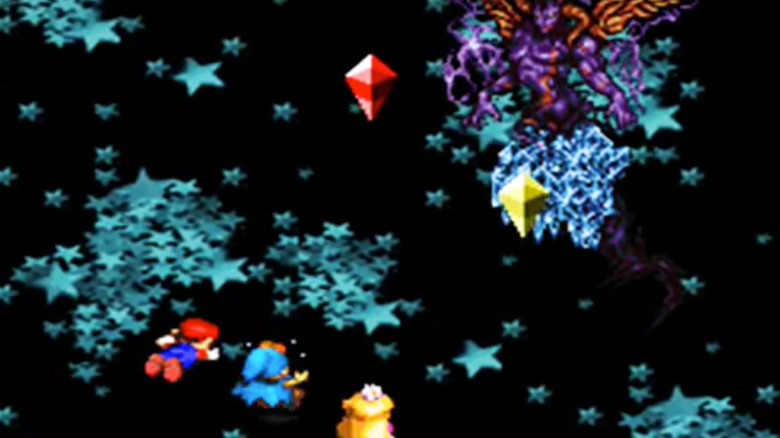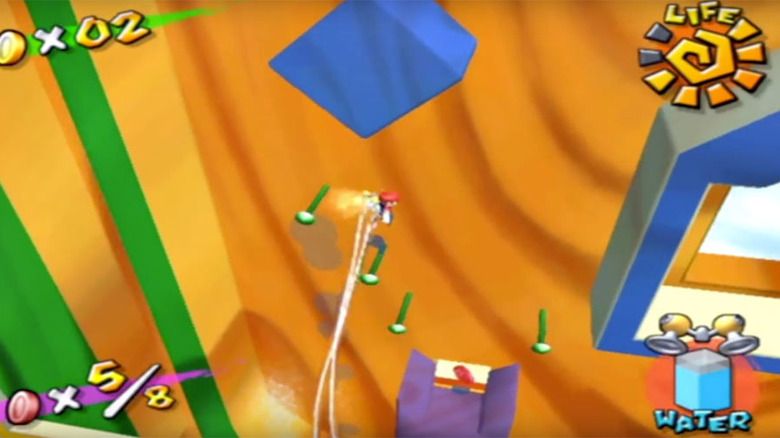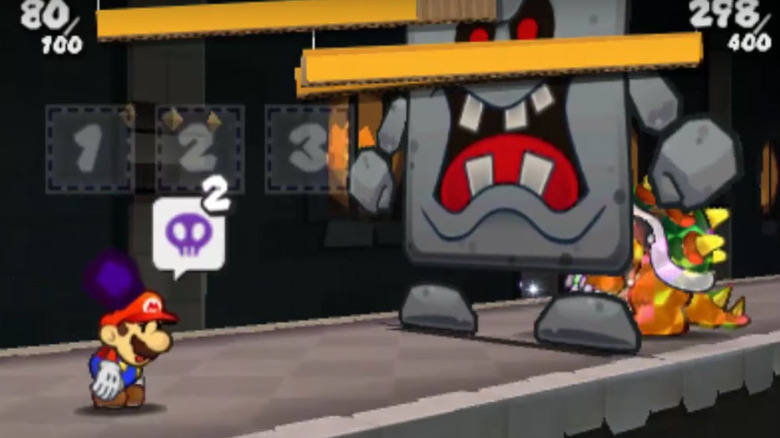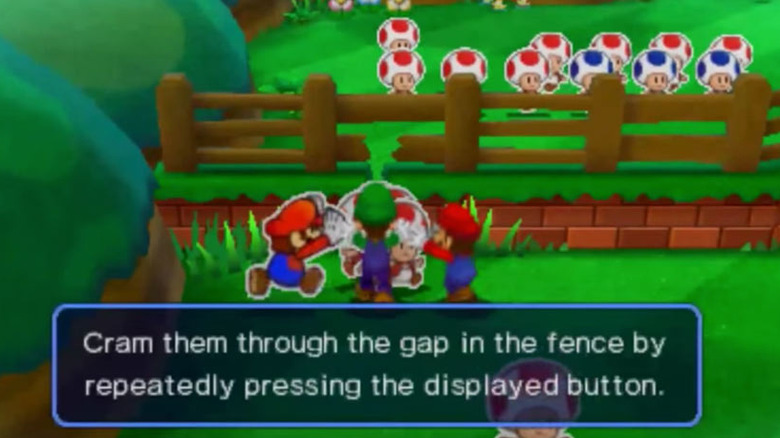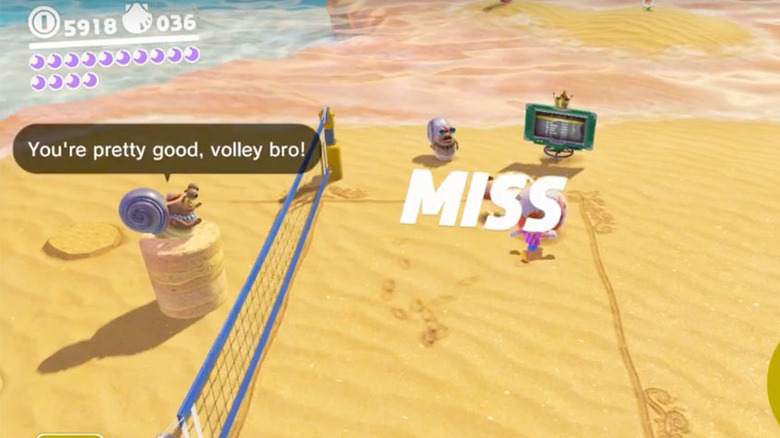Frustrating Mario Levels That Made Us Want To Rage Quit
With their bright colors, simple controls, and cartoony bad guys, the Super Mario series has always been one of the most accessible franchises in video games. For over 30 years, they've been a master class in intuitive design that teaches players what to do as they go, providing consistent rewards and, most of all, fun. They're favorites for the whole family, with levels that are simple enough for a kid to learn and a steady difficulty curve that excels at never getting too challenging ... except when they take a sharp turn that goes way past difficult and straight into outright cruelty.
Every now and then, the designers at Nintendo show that they've got a mean streak that runs as deep as anyone who's ever worked on Dark Souls. From punishing bonus stages to tedious side quests to sharp spikes in difficulty that'll make you wish you were playing Sonic instead, here are the frustrating Mario moments that made us want to rage quit.
Super Mario Bros.: World 8-3 had hammers and more hammers
When Super Mario Bros. hit the NES in 1985, it pretty much defined video games for an entire generation. Part of that has to do with the fact that it's a genuinely great game that took simple run 'n' jump platforming into 32 well-crafted levels that, for the time, made for one massive adventure. The other part, though, comes from the genius move of including it as a free pack-in title with the console, ensuring that gamers would play it more than anything else. If you're in your 30s, there's a good chance you could get through World 1-1 wearing a blindfold, purely based on muscle memory.
Whether you can actually beat the game, though, depends on if you managed to make it through World 8-3 without snapping your controller in half. Sure, you'd expect the game's penultimate level to be pretty challenging, but the enemy placement here makes this one a short, brutal gauntlet of Hammer Bros that's almost unfair.
But only almost. There are power-ups that can make it a lot easier — although they're hidden and require a lot of trial and error to find them the first time through — but by dropping bad guys exactly where you want to jump and land and loading the last stretch with a seemingly endless shower of hammers, the designers make it almost impossible for you to hold onto them for the duration. It's far from impossible, but it's a nice hint at the cruelty to come.
The Lost Levels: Reverse Warp Zones were too hard for American players
One of the most well-known pieces of video game trivia is that the United States got a completely different version of Super Mario Bros. 2 than the one released in Japan. In America, we got the fun but massively weird re-skin of Doki Doki Panic, but the Japanese audience got a game that was basically just more of the original. The reason for the switch was that Nintendo considered Japan's SMB2 to be too difficult for the American audience. That might seem a little insulting, but when Americans finally got to play the rechristened Lost Levels in 1993, well, it turned out that Nintendo probably wasn't wrong.
The entire game is one grinding deathtrap after another, complete with the infamous Poison Mushroom and levels where getting a power-up actually makes them impossible to complete. Its cruelest trick, though, is undoubtedly the reverse warp zone.
While most of the game's warp zones offer up the standard jump forward, two of them actually send you backwards — including one in World 3 that'll drop you right back at the beginning of the game at good ol' 1-1. Even worse, if you make it all the way to world 8 and discover the secret there, your reward is being dropped back in World 5. You're not given a choice, either; unlike the original SMB, each zone only contains one pipe, and since you can't back up, taking it is your only option, good or bad.
The Lost Levels: World 9 was so hard, it came after the game was already over
Let's say you sit down with The Lost Levels, and since you learned your lesson about the Warp Zones, you play straight through, from 1-1 to 8-4. After 32 solid levels of pixel-perfect jumps, wicked traps, and levels that'll loop around endlesly, you finally get past Bowser, save the princess, and beat the game.
Except you don't.
Instead, you get World 9: four more levels that you have to get through in a single life. They're described onscreen as a "fantasy world," although considering how disorienting they are, it feels like that might be a mistranslation of "nightmare." Despite using the overworld and castle graphics, the World 9 levels use underwater physics, giving Mario the appearance of swimming through the air while avoiding the kinds of enemies that you don't usually find in the water stages. If you're used to Mario games, it's enough of a shocking difference that you might just lose that one and only life you've been given trying to get past the first Piranha Plants, and then you're right back where you started.
Good news, though: if you beat those, you still haven't actually beaten the game. There are four more worlds (A, B, C, and D) that are every bit as hard as the rest of the game, including one where you have to soar through the air being carried along by wind while trying to make a precise landing on a series of springboards, all without actually being able to see Mario. Thanks, but maybe we'll just stick with hopping on Birdo's eggs.
Super Mario Bros. 3: 6-5 made you realize that you were doing it wrong
One thing that the Mario games generally excel at is giving you the tools you need to finish the job. With the exception of some of the more devious parts of The Lost Levels, you're almost never going to encounter a stage with a puzzle that requires something you can't find within that same stage. Putting it all together, on the other hand, can be a whole different matter.
Witness, for instance, World 6-5, the single most teeth-grindingly frustrating level of Mario's NES masterpiece, Super Mario Bros. 3. At the end of the day, the solution here is actually pretty simple — you just have to think about flying up instead of moving horizontally towards your goal — but the trick is that you have to carry a shell with you. Considering this is the only time in the entire game that this is necessary, and that the rest of the stage loops around with a couple of pipes, actually figuring that out can take the whole 400 seconds that you're given on the level's counter. Of course, there's also the matter of it actually being pretty hard to hold down B to keep hold of the shell while you're tapping A to fly with a raccoon tail, but you can solve that by using two fingers instead of a single thumb.
Yes: This level actually makes you change how you're physically holding the controller, making it one of the only Mario levels to ever tell you you're doing something wrong in real life.
Super Mario World: Tubular brought balloons and existential horror
Super Mario World is a whole lot of game. Not only are there the sprawling regular stages, but the Star Roads lead to five secret levels, and if you complete those the right way, and you get access to the Special Zone: eight more levels, each one based on a specific gimmick. For the most part, they're pretty fun, from a stage built around vertical travel to one extremely long stage that you're given a tight time limit to blow through as fast as you can — with unique berries that will give you extra time if you were lucky enough to bring Yoshi. It's even got a playable version of the stage from the title screen!
And then there's Tubular.
It's the second stage that you come across in the Special Zone, and it's enough to make you give up on ever getting through the other six. The gimmick here is that after a series of tight jumps, you have to inflate Mario like a balloon and guide him through a series of obstacles with no ground below you, avoiding moving obstacles and making sure to get a new balloon every few seconds. Considering that being a balloon makes Mario a lot more sluggish, it's an incredibly frustrating challenge, but hey! Make it through (and complete the other Special Zone stages) and you'll be rewarded by an irreversible Halloween-themed color-scheme swap of the entire game, where Piranha Plants are jack-o'-lanterns and Koopas are wearing Mario's face instead of their shells. Who doesn't love that kind of existential horror?
Super Mario World 2 - Yoshi's Island: Poochy Ain't Stupid was stupidly hard
If you can get past the constant crying sounds that happen whenever you drop Baby Mario, then Yoshi's Island is one of the best games to ever hit the Super NES. If you can't, well, maybe you should skip it — and definitely don't attempt the first world's extra stage, "Poochy Ain't Stupid."
For starters, it includes everyone's least favorite Mario game mechanic: auto-scrolling! The bigger problem, though, is that you're playing a very literal game of The Floor Is Lava, where you're tasked with balancing on the back of a giant, mysteriously magma-proof dog named Poochy as he meanders through the stage. Throw in the obstacles, and you're inevitably going to drop Baby Mario, and hear that 16-bit wailing over and over again, while he's hovering above a floor you can't stand on with a screen that's pushing you further into the stage.
And the worst part? It doesn't even make sense! Poochy's just a regular dog who doesn't wear shoes! If anyone's going to be able to stand around in lava, it should be Yoshi! He's the one who's got boots!
Super Mario RPG: Culex brought a little Final Fantasy to the mix
While the Final Fantasy games were becoming increasingly complex stories about Espers and Magicite, Square's collaboration with Nintendo was the perfect entry-level RPG. With simple controls, a story that took you on a grand tour of the Mushroom Kingdom and put Peach and Bowser into playable roles, and even a couple of cool new characters who never made a comeback, Super Mario RPG is justifiably regarded as a classic. There is, however, one element of more complicated RPGs that Square made sure to include: an optional boss fight that was way more powerful than anything else you'll face in the game.
Culex actually has the pretty hilarious distinction of just being a straight-up Final Fantasy boss, right down to having a 2D sprite instead of the "3D" models of all the other characters. But that means that unlike characters who are swinging around frying pans and the same hammers they were using to fight Donkey Kong, he's got attacks like devastating laser beams and literally calling down a star from the heavens to stomp on your head until you're dead.
It's an arduous fight, but it is winnable, if you show up prepared late enough in the game. If, however, you're one of those young fans coming into an RPG for the first time because it's got your old pal Mario in it, it's a different story. Culex is not only going to be a devastating opponent, he's going to make the final boss seem pretty underwhelming, too.
Super Mario Sunshine: Pachinko turned Mario into a pinball
Pachinko is an incredibly popular pastime in Japan, but for some reason, it's never really caught on for American audiences. Even the video game versions, which were popular enough that there are the roughly 7,000 Pachinko games that were made for the Game Boy alone, tended to be kept in Japan and never made it to Western audiences. It might be because that particular niche is filled by pinball on this side of the Pacific, but now that we're really thinking about it, it could be because it lacks two crucial elements that American audiences just love: motion sickness and acrophobia.
That seems to be what Nintendo was thinking when they dropped a giant Pachinko machine into Super Mario Sunshine. It's a pretty straightforward collect-the-coins bonus level, it exists in the same boundless pocket dimension where you can find all of the other bonus stages, which translate the bottomless pits of the other games into a dizzying 3D abyss. Combine that with the way that the Pachinko setup bounces Mario around the front and back of the machine, sending him sliding back to the start every time you miss an opening, and you've got an experience that's both frustratingly difficult and can literally make you sick.
Paper Mario Sticker Star: Grinding your way down the final road to Bowser
Every Paper Mario game is built around adding a new mechanic to the storybook setup that first debuted on the N64. With Sticker Star, as the title implies, it was using "stickers" to represent every single action that Mario could do in battle, combining inventory management with battle strategy. It's interesting and results in some great aesthetics, but in terms of actually making for a fun game, you could charitably say it's hit and miss.
Every single attack, no matter how basic, is taking up space in your very limited inventory, and more powerful attacks naturally take up more room. In order to make the most of it, you're forced to slog through battles to get the best attacks — a process that can actually cause you to use up the attacks that you're trying to save if you wind up in a fight that takes too long. Normally, that's not a huge problem, but going into the final battle against Bowser, it becomes a real pain.
The entire fight is designed to drain your resources. It's a literal long hallway where you have to fight through several lesser enemies, including ones that require very specific attacks, before you even get to the actual boss. To say that it's a grind is putting it mildly, but at least there's the cool moment at the end where you get powered up to five attacks per round. Assuming you still have five attacks in your inventory, that is.
Mario & Luigi - Paper Jam: Toad Hunts were unskippable
No matter how offbeat they can get with water-powered jetpacks, spaceships shaped like your own head, or a magic hat that can possess a Tyrannosaurus, the core gameplay of every Mario game is solid. It's only when they start veering off into minigames and side quests that things begin to go off the rails, and Paper Jam goes so far that it lands right in the middle of a volcano.
In combining two fan-favorite Action-RPG takes on the Mario Bros. — the Mario & Luigi and Paper Mario series — Mario & Luigi: Paper Jam actually did some really interesting stuff. Unfortunately, it also introduced a minigame about rounding up paper Toads that manages to pop up and derail your game with mind-numbing tedium every time things are getting fun.
If you've ever played any mandatory minigames, then you already know how this one goes, but the AV Club might've put it best when they said the Paper Toad stages were "emblematic of its wrongheaded insistence on forcing unnatural pace and needless variety onto an otherwise charming adventure." And honestly? That's the nicest thing you can say about them.
Super Mario Odyssey: Beach Volleyball got sand directly in Mario's craw
There are 999 Power Moons in Super Mario Odyssey, and the nice thing about that is that you'll trip over four or five of them just wandering through the game. If, however, you're the kind of completist who actually wants to see all the levels in the game, you're going to have to put in the effort to do some pretty ridiculous things.
The most infamously pointless time-wasters are, of course, the challenges where Super Mario Odyssey suddenly turns into a completely different game, as though Toady Hawk's Pro Jump Rope and Dead or Alive X-Treme Beach Volleyball: Mushroom Kingdom Edition were the real killer titles that the Switch was waiting for. Between the two of them, the volleyball minigame is definitely the worst, since you can't quite tell when the Cheep Cheep-shaped ball is low enough to smack back across the net with your magic hat.
Stick with it, though — or get frustrated enough after countless failures that you decide to cheat it by just switching over to Cappy in two-player mode — and you'll get your Power Moon. You know, the same thing you can get by, say, having a conversation with Captain Toad, or buying them at any store in the game. Really makes it seem worth it, doesn't it?

